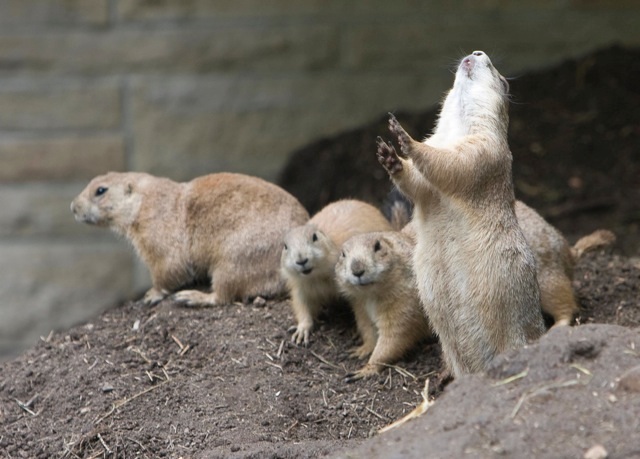Furry Fans: Why Prairie Dogs Do 'the Wave'

Prairie dogs foraging near their burrows frequently pop up on their back legs, front paws in the air, and cry "wee-oo," a behavior that spreads throughout the pack as quickly as "the wave" at a football game. Now, research suggests these adorable "jump-yips" are tests of the emergency broadcasting system.
Prairie dogs jump-yip to make sure their neighbors are on the alert, according to a new study published today (Jan. 7) in the journal Proceedings of the Royal Society B. If the animals get a lot of responses, they relax a little, foraging more and spending less time scanning the horizon for predators.
"Probably the most striking implication of the whole thing is it reveals to us that these prairie dogs have a concept of others as unique individuals," said study researcher James Hare, a biologist at the University of Manitoba. "They are capitalizing on others' awareness and actively probing that awareness." [See Video of the Prairie Dog 'Wave']
Jump-yip mystery
Prairie dogs find strength in numbers, and scientists knew that the rodents employ a complex system of alarm calls when danger nears. The purpose of jump-yips, though, had remained mysterious.
"I started to think of it as a potential test of the emergency broadcast system," Hare told LiveScience. It was possible, he thought, the prairie dogs were simply making sure their neighbors were paying attention.
One of Hare's graduate students, Robert Senkiw, travelled to North and South Dakota to observe black-tailed prairie dogs (Cynomys ludovicianus) in the wild. Senkiw also made observations in two prairie dog "towns" in Manitoba.
Sign up for the Live Science daily newsletter now
Get the world’s most fascinating discoveries delivered straight to your inbox.
Senkiw captured video of the prairie dogs going about their daily foraging behavior. He recorded 173 total bouts of jump-yipping and their immediate aftermath.
The videos revealed the behavior of the instigating prairie dog depended on how far and fast the jump-yipping spread. If lots of other prairie dogs mimicked the behavior quickly, the first jump-yipper foraged more diligently and looked around for predators less often. If few prairie dogs responded to the jump-yipping, the instigator became more vigilant.
On guard!
The behavior provides a feedback loop so that prairie dogs are constantly sure that someone's on guard, Hare said. Previous studies have shown that group living does reduce predation, but this research takes those observations a step further.
"It's not only the number of individuals, but whether or not they're aware," Hare said. "You can have — I don't mean to put it in human terms — but a room full of dullards."
Follow-up studies should look at whether a prairie dog's location in the colony, individual personality and reproductive status affect its likelihood of jump-yipping, Hare said. He also wants to examine whether the animals pay attention to directionality: If prairie dogs only to the south of an instigator jump-yip, does that prairie dog start paying more attention to potential threats from the north?
Contagious communication in other animals is a sign that the animals have a theory of mind, a term describing the ability to understand the mental state of others. Human babies start to develop this skill in toddlerhood, studies suggest, but other animals have it, too. Chimpanzees are capable of understanding the needs of other chimps, according to a 2012 study. And dogs are more likely to catch a yawn from a person they're bonded with versus a stranger (yawning is thought to be linked with empathy).
Prairie dogs aren't the only group-living animals that depend on contagious behavior for survival, Hare said. Emperor penguins in Antarctica also "do the wave" as they shuffle into the perfect huddle for warmth. The little, burrowing rodents are, however, among the animal experts at social behavior, Hare said.
Nevertheless, farmers and ranchers despise prairie dogs because of their burrows, and try to get rid of the rodents.
"We're working to eliminate an incredibly intelligent creature that is as social as ourselves," Hare said. "We have to have some respect for species that have this sort of advanced sociality and [that] cooperate in meaningful ways."
Follow Stephanie Pappas on Twitter and Google+. Follow us @livescience, Facebook & Google+. Original article on LiveScience.

Stephanie Pappas is a contributing writer for Live Science, covering topics ranging from geoscience to archaeology to the human brain and behavior. She was previously a senior writer for Live Science but is now a freelancer based in Denver, Colorado, and regularly contributes to Scientific American and The Monitor, the monthly magazine of the American Psychological Association. Stephanie received a bachelor's degree in psychology from the University of South Carolina and a graduate certificate in science communication from the University of California, Santa Cruz.









